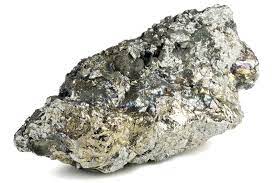Identity.
Manganese (Mn) is a naturally occurring element that is found in rock,
soil, water, and food.
Atomic Structure:
The nucleus consists of 25 protons (red) and 30 neutrons (blue). 25
electrons (green) bind to the nucleus, successively occupying
available electron shells (rings).
History.
Manganese's history stretches back millennia. Evidence suggests early
humans used manganese oxides, found in cave paintings around 30,000
years ago, for their colorful pigments. Fast forward to the 18th
century, scientists began unraveling the element's secrets. In 1774,
Swedish chemist Carl Wilhelm Scheele identified manganese in a
mineral, while his colleague Johan Gottlieb Gahn later isolated the
pure metal.
The 19th century saw manganese gain industrial importance. Its
ability to strengthen steel revolutionized various industries,
from construction to transportation. Today, manganese remains a
vital component in steel production, but its uses extend far
beyond. From batteries to fertilizers, this versatile element
continues to shape our world in countless ways.
Usage.
Manganese is used to produce a variety of important alloys and to
deoxidize steel and desulfurize. It is also used in dry cell
batteries. Manganese is used as a black-brown pigment in paint. It is
an essential trace element for living creatures.
It is mainly used in alloys, such as steel. Steel contains about 1%
manganese, to increase the strength and also improve workability and
resistance to wear. Manganese steel contains about 13% manganese. This
is extremely strong and is used for railway tracks, safes, rifle
barrels and prison bars.
Some of the benefits of using manganese are:
-
Manganese may play a role in helping the body use insulin to
regulate blood sugar levels.
-
Manganese is involved in collagen production, which is important
for wound healing.
-
Manganese is a cofactor for many enzymes in the body, which are
involved in various metabolic processes.
Sources.
Manganese is present in a wide variety of foods, including whole
grains, clams, oysters, mussels, nuts, soybeans and other legumes,
rice, leafy vegetables, coffee, tea, and many spices such as black
pepper.

